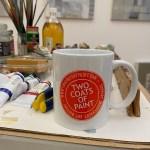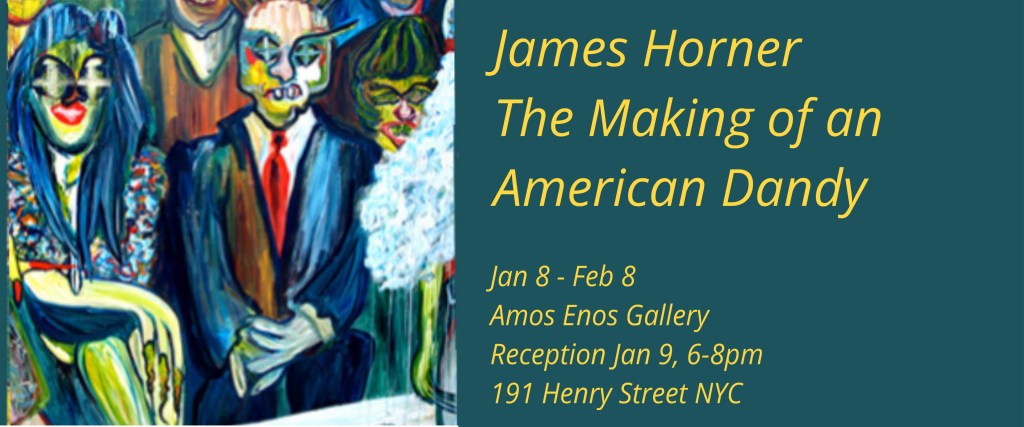
Louis Fratino, Duomo, 2023, oil on canvas, 24 x 22 inches
Contributed by Margaret McCann / Louis Fratino’s paintings in “In bed and abroad” at Sikkema Jenkins depict varied social situations, from intimate scenes to foreign climes. Snapshots of memories, many from Italy, read like a travel diary. In Duomo, light seems to dissolve a church façade into a gossamer veil, like Monet’s series of Rouen. Milan’s iconic gothic cathedral is strikingly illuminated, as are most monuments in Italy at night. Silhouetted throngs of young people in front of it have gathered after their evening stroll to aid digestion, take in the sumptuous surroundings, and see what’s happening in the local piazza. This saunter or “passegiata” is also “a walk in the park,” and the painting’s mellifluous drama demonstrates Fratino’s impressive facility, as it captures the Italian relish of visual and other small pleasures, which Americans often mistake for sunny dispositions (see Fellini’s La Dolce Vita).

Louis Fratino, Red Nude (After Mafai), 2023, oil on canvas 65 x 94 inches
Fratino’s flowing style nods to Matisse and Picasso, and his more cavalier action and fleshier paint to their admirer David Park. Fratino is a millennial, of the first computerized generation, and the cultural shaping of animation’s lighthearted, clear, swift shapes, as in “Astro Boy” or the increasingly speedy “Spider Man,” is operative. Red Nude (After Mafai) is an homage to the Scuola Romana painter Mario Mafai. Painted with the aplomb of Neo-Expressionists like Jorg Immendorf, the resting figure could almost be flying. Descriptive shortcuts yield humorously rubbery arms, skillfully tempered by subtle chiaroscuro, rich but unsaturated hues in smart temperature shifts, and redolent facture. Contemporary painting often disappoints up close due to a lack of texture – the haptic layering that, even if thin, captures gesture in response to form, and records the accrual of that history on the surface. A function of the human body, texture is one factor that should thankfully maintain good painting’s independence from AI-generated facsmilie.

Louis Fratino, Piazza Affari, 2023, oil on canvas, 35 x 24 1/8 inches
In Piazza Affari, simplification plays off specific light and shadow under daylight. It depicts one of Leone Lodi‘s allegorical sculptures on the facade of Milan’s stock exchange. Lodi was inspired by the Romanesque sculptor Benedetto Antelmi, and associated with Mussolini’s promotion of modernization and national identity, as were Lodi’s friend Mario Sironi, and others like Carol Carra. (Unlike Hitler and Stalin, Il Duce did not enforce a conservative painting style, so stylistically progressive artists had less inducement to emigrate.) Fratino’s interest in the early twentieth century’s earthy geometric figuration is understandable, though it would have been odd for an openly gay artist in New York City to draw inspiration from fascist art not too long ago, given Clement Greenberg’s directives. But the resurgence of figurative painting via the internet has fostered a recalibration of historical trajectories and global cultural cross-pollination. For those who believe in painting’s lasting power, solid examples can withstand changing cultural values, survive revisionism, and cast off the obsolete while maintaining essential visual identity.

Louis Fratino, Cato, 2023, oil on canvas, 37 ½ x 43 ¾ inches
Fratino’s confident ability stands out even in a minimal image like Cato, in which a simple postcard view of the rolling hills of the Cinque Terre region is superbly organized. Proportions of colors, shapes, and textures; illusions of space, volume, light, movement, and touch; and contrasts of levity and gravity, all effortlessly congeal into a durable pictorial order.

Louis Fratino, Arci Bellezza, 2023, oil on canvas, 50 1/8 x 34 inches
Happening and happiness share the root meaning of fortunate occurrence, and in Arci Bellezza, Fratino’s upbeat, dancing rhythms assume human form. A nimble elasticity, like that of Mr. Fantastic, energizes couples crowding the dance floor of a private social club in Milan. All ages are welcome, and lower left an older woman, shoes on the table, rests her feet. Above her, a man with a roving side eye targets the viewer. Across the way, a gay couple joins the vertical column of shapes moving counterclockwise across the surface and back into the space. Above, arms doing the tango point left like an arrow, enacting the directionality students learn in design class. Fluid fragmentation of the surface recalls the Synthetic Cubism of Picasso, Jean Metzinger, Fernand Leger, and Robert Delaunay, or the Cubo-Futurism of Gino Severini.

Louis Fratino, YMCA, 2023, oil and canvas, 62 1/8 x 54 1/8 inches
The more static YMCA looks closer to Analytical Cubism. A swimmer seen from behind, anchored by the visual weight of a negative shape wedged under his arm, leads up the aisle between shower stalls. At the far end, another recalls Cezanne’s Bather (sans loincloth) in a witty inversion of our approach to that painting. To his right, another sensually washes his back, and the potential for triangulating interpersonal drama is set. But encircling like future versions of them, like numbers on a clock face, are five older men in profile, some of whom resemble a debauched Martin Kippenberger character. The painting might spoof Picasso’s Les Demoiselles d’Avignon (as John Currin did), whose palette it basically shares. Instead of glaring prostitutes, however, each man with downcast eyes is quietly absorbed in a steamy but cleansing shower. If inspired by the “Y” on the outskirts of Rome, the painting might comment on queer loneliness in Italy. But although the song “YMCA” is a gay anthem, a scene of men bathing in Italy can easily conjure its mighty baths (from which NYC’s baths derive). The men here could be straight and thinking about Rome. In any case, sharp edges evenly disperse attention, bringing discrete scenes of isolation into sympathy. Tonal nimbleness creates believable light; the image shimmers like a mirror.

Louis Fratino, Kiss, 2023, oil on canvas, 43 5/8 x 43 5/8 inches
In Kiss, dynamics of separation and mingling occur through ebullient figure-ground interaction, as forthright as that of Markus Lupertz and his antecedent Max Beckmann. A tenderly pornographic splayed crotch echoes Courbet’s Origin of Life with the frankness of Pompeian signage – or Tom of Finland‘s couples, with whom Fratino shares curvilinear verve. Unabashed light reveals all, nothing hides in the shadows.

Louis Fratino, The Beach at Noli, 2023, oil on canvas, 75 1/4 x 105 1/8 inches
Distinct figures and groups dispersed across The Beach at Noli are again enclosed in private experiences but connected in communal enjoyment. The undulating horizon of verdant mountains and blue water relaxes like a scene by Raoul Dufy. The slight twist of the dozing figure laid out along the foreground, who might be dreaming the scenario up, anticipates the expanding landscape winding into depth. Small-scale humans become attributes of the innocent, arcadian scene. While Fratino’s palette eschews saturated color, his joie de vivre recalls that of Matisse, who borrowed the title Luxe, Calme e Volupte from Baudelaire’s poetry: “There, all is order and beauty / Luxury, peace, and pleasure.” Whether luxuriating in ordinary or exotic experience, Fratino’s exemplary and optimistic merging of form and content evokes the deep pleasure of achieving that equilibrium.
“Louis Fratino: In bed and abroad,” Sikkema Jenkins, 530 West 22nd Street, New York, NY. Through December 9, 2023.
About the author: Painter and art writer Margaret McCann teaches at the Art Students League. She has shown her work at Antonia Jannone in Milan and been reviewed in La Repubblica, Corriere della Sera and the Huffington Post. She edited The Figure (Skira/Rizzoli 2014) for the New York Academy of Art and has written reviews for Painters’ Table and Art New England as well as Two Coats of Paint.
NOTE: The Two Coats of Paint 2023 Year-end Fundraising Campaign is in the final weeks, and our goal this year is to reach 100% reader and gallery participation. For contributions of $150 and above, we’ll send a gift — one of the new Two Coats of Paint coffee mugs. Every gallery should have one, right? Please consider making a tax deductible contribution to support the project in 2024. Thank you for all your help keeping the conversation going.























